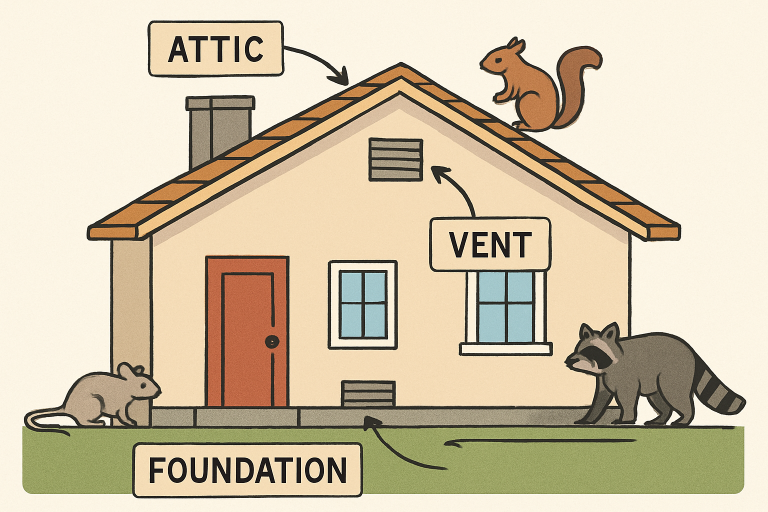Unwanted critters can quickly turn a home chaotic and damaging, as animals like rodents, raccoons, bats, and squirrels reproduce and nest rapidly. Early detection and prompt action are essential, since delays allow infestations to escalate, threatening health, property, and the environment. Seasonal behaviors can further influence wildlife activity, making timely intervention crucial. Expert removal and prevention strategies help restore safety, minimize disease and allergen risks, and protect your home before problems worsen.
What Makes Timely Critter Control Critical?
The Rapid Spread and Nesting Behavior of Nuisance Animals
Many critters of all kinds, including rodents and birds, multiply quickly and build nests in hard-to-reach places inside homes. Once a single animal finds entry, it invites others, creating an exploding population that’s difficult to manage. Mice, for example, can produce litters every month, and raccoons are notorious for tearing insulation and creating large communal nests.
How Small Problems Can Escalate Quickly
It may start with a faint scratching noise, but in just a few weeks, a small family of animals can become a destructive infestation. The longer pests remain, the more likely they are to chew wires, spread droppings, and contaminate food sources—quickly rendering simple solutions ineffective and requiring professional intervention.

Common Signs an Infestation Is Starting
Noises, Droppings, or Property Damage
The most common early warning signs of critters include unexplained scratching, squeaking, or movement in the walls, attic, or basement. Physical evidence such as gnaw marks, nests made of insulation or paper, unexplained debris, or animal droppings should raise immediate concern. Damaged vent covers, holes near foundations, or oily smudges near entry points indicate that wildlife has broken in. According to This Old House, animals like mice, bats, and squirrels often enter through small gaps in the foundation, roof, or walls, and can cause damage by chewing on wires, insulation, and other structural components. Therefore, inspecting your home and sealing potential entry points is essential.
Understanding Seasonal Critter Patterns
Certain pests are more active during particular seasons. Rodents and squirrels look for warmth as temperatures drop, while birds and raccoons seek shelter and nesting sites during the spring. Familiarity with these seasonal trends helps homeowners remain vigilant and proactive, minimizing the risk of unexpected infestations.
Health and Property Risks Linked to Delayed Removal
Disease Transmission and Allergens
Wildlife intrusions aren’t just inconvenient; they’re dangerous. Rodents and bats can transmit serious diseases, such as hantavirus and histoplasmosis, while their droppings promote the growth of mold and bacteria, which can trigger allergic reactions or respiratory problems. According to the EPA, pests can pose various public health risks, underscoring the importance of timely prevention and control measures.
Structural Damage and Fire Hazards
Gnawing animals can cause significant structural or wiring damage, increasing the risk of electrical fires. Insulation, wood, and drywall may become compromised as animals nest or burrow, leading to expensive repairs and insurance claims if issues are not addressed promptly.
Environmental Impacts of Ignoring Wildlife Intrusions
Effect on Local Ecosystems
Failing to control critters humanely can upset local ecosystems. Animals removed improperly or left unchecked can disrupt native species populations or spread invasive species, leading to long-term ecological imbalances in the area.
Ethical Handling of Wildlife
Every property owner should take responsibility for safely and humanely removing critters. Professionals employ relocation and exclusion techniques that minimize harm, adhering to wildlife protection guidelines while ensuring the animals do not return.
Top Tips for Preventing Infestations Before They Happen
Home and Property Maintenance
Seal gaps and cracks around foundations, eaves, and vents to prevent air infiltration. Eliminate food sources by securely storing trash, cleaning up outdoor eating areas, and trimming back trees or shrubs that might provide access to roofs. Regularly inspect high-risk areas, such as attics, garages, and basements, especially during seasonal changes.
Educating Household Members on Prevention
Teach everyone in the home what to look for and how to respond if critters are detected. Early intervention—such as blocking entry points or reporting changes in animal activity—can often prevent an infestation from ever taking hold.
Conclusion
Unwanted critters pose a serious threat to a home's safety and comfort. Their rapid reproduction, seasonal behaviors, and tendency to damage property mean that even minor signs such as scratching, droppings, or gnaw marks should prompt immediate attention. Delaying action can escalate risks to health, structure, and the environment, while timely intervention, especially with professional assistance, helps prevent minor problems from turning into major infestations. By understanding seasonal patterns, recognizing early warning signs, and implementing preventive measures such as sealing entry points and educating household members, homeowners can protect their property and family while handling wildlife ethically and responsibly. Ultimately, proactive vigilance is the most effective strategy for keeping homes critter-free.



No comments:
Post a Comment
I love reading and responding to comments but in order to get my reply you must ensure you are NOT a no-reply blogger. If you are, here are some quick steps to change that!
1. Go to the home page of your Blogger account.
2. Select the drop down beside your name on the top right corner and choose Blogger Profile.
3. Select Edit Profile at the top right.
4. Select the Show My Email Address box.
5. Hit Save Profile.